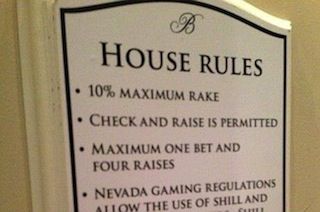Three Reasons to Check-Raise in No-Limit Hold'em

The check-raise is a powerful though not necessarily well understood move in no-limit hold'em. Playing from out of position after flop is never desirable, but knowing when and how to employ the check-raise can help a lot.
Every action in no-limit hold'em is made for a reason (or multiple reasons) — at least that is what should be the case. When it comes to check-raising, there are a few specific reasons for making this postflop move. Let's look at three of most common ones.
1. Check-Raise to Show Strength
Aside from an all-in shove, a check-raise is perhaps the most conspicuous show of strength a player can make in a hand of no-limit hold'em.
New players sometimes fail to appreciate just how strong a check-raise can appear to be. Such players might call a late-position raise from the blinds with a small pocket pair, flop bottom set, then make a big check-raise only to earn a fold and a smallish pot as a reward. They don't realize the check-raise can be scary, often making it hard for opponents to continue with weak or medium-strength holdings.
Since the check-raise does signal strength, think about reasons why you might want to give an indication you have a strong hand. Most often for those playing out of position, showing strength is a way of getting an opponent either to fold or to slow down after you've taken away the postflop initiative.
When do you want your opponent to fold? When you have a weaker hand, in which case you are check-raising as a bluff (a false show of strength). Or when you have a strong but vulnerable hand, in which case you aren't bluffing but protecting your hand by check-raising the flop or turn. If your check-raise is called on the flop, a leading bet following a safe-seeming turn card can be even tougher for an opponent to call with a so-so holding, knowing that there will likely be another bet on the river to come.
In multi-way pots, check-raising can also serve to "clear the field" in an attempt either to take a pot down right there or create a heads-up situation versus the lone bettor. That can be a desired outcome even with second-best hands that can subsequently improve, or also with drawing hands.
Say you check-raise the flop with a flush draw and get one caller. If the flush comes on the turn, your hand is potentially disguised as your opponent might think you were check-raising to protect your hand. If the turn is a blank, you can lead as a semi-bluff, or if you check your opponent may well check behind out of fear that you might be poised to check-raise again.
2. Check-Raise to Be Deceptive
The other fundamental truth about check-raises aside from being shows of strength is that they are essentially deceptive. Think about it — rather than simply lead with a bet, it's a non-straightforward, multi-stage procedure that gives the impression of having drawn an opponent into a "trap" when his or her bet doesn't elicit a fold or a mere call, but an antagonistic raise.

There was a time in poker when the check-raise was actually looked down upon by some as a kind of breach of etiquette. In fact in certain games and poker rooms the check-raise was even prohibited. A sign listing "House Rules" in the Bellagio poker room includes a nod to that old rule by pointing out that a "check and raise is permitted."
Even today you might find yourself in a home game full of inexperienced players who similarly think there's something wrong with check-raising. It could even happen at a "friendly," passive, low-stakes table in a poker room that you encounter a player taking offense after being check-raised. That's because such players don't like being made to feel like they've been fooled or deceived in some way.
But that's often the point of the check-raise — to be deceptive.
Players who choose to check-raise need to be mindful of this fact. Don't stumble into a check-raise as an afterthought after checking and watching an opponent bet (as some amateurs do). Have in place a planned course of action that involves manipulating your opponent into betting and opening the door to your check-raise.
I've found myself in certain games where only some players present are even capable of check-raising, with others simply leading out or check-calling whenever playing from out of position. Players who check-raise generally gives the impression of being able to think an extra step ahead in a hand. The ones who check-raise successfully are often given even more credit.
It must be added, of course, that you don't want to be deceptive just for the sake of being deceptive or to be thought of as a player able to make "fancy," non-straightforward plays. Rather be deceptive and use indirection to accomplish a specific goal in a given hand, or to help build a certain image which you can exploit later in a session.
3. Check-Raise to Build a Bigger Pot
A third reason to check-raise can be to build a bigger pot when holding a strong hand, but only if current conditions suggest check-raising to be the best way to get more chips in the middle. These conditions include:
- you have a strong hand
- you believe your hand is likely stronger than your opponent's hand
- you believe your opponent will bet if you check
Go back to that situation described above where a player flops a set of fours from the blinds against a late-position raiser. Check-raising big might scare an opponent out of the hand, but against certain passive or "sticky" opponents who hate folding, a smaller check-raise might be the best way to start building a pot and create a big payoff.
Check-raising to build a bigger pot often also has a lot to do with flop texture and the likelihood of your opponent having caught at least some of the board to encourage continuing with the hand.
If you have pocket fours and the flop comes 8♦4♣2♥, such a flop misses most hands in your opponent's late-position preflop raising range, meaning a check-raise might win you one small continuation bet and nothing more. But if an A♣K♦4♣ flop gives you your set of fours, your opponent could have a big pair or draw and want to stick around even after you check-raise.
Conclusion
Ideally, each action you choose to take in a hand of no-limit hold'em is performed for a reason (or more than one reason). But the check-raise is a special action, requiring a little extra focus and attention and planning. Be smart with your check-raises, always having a good idea why you are check-raising when you do.
Want to stay atop all the latest in the poker world? If so, make sure to get PokerNews updates on your social media outlets. Follow us on Twitter and find us on both Facebook and Google+!









